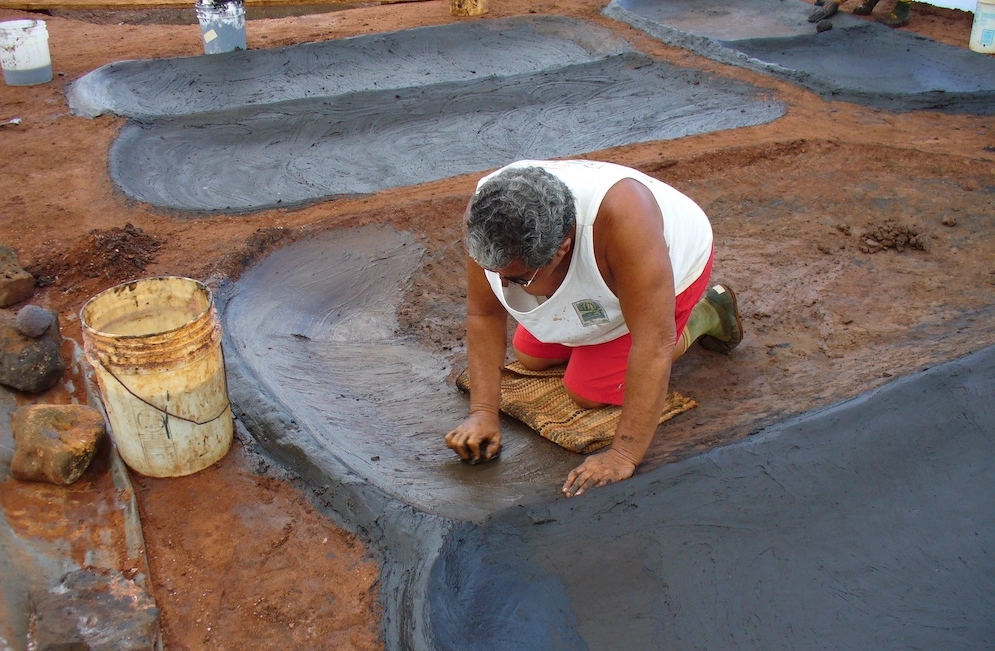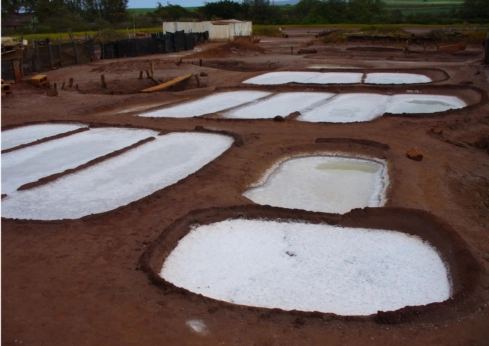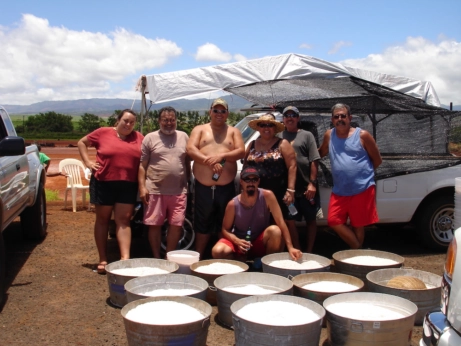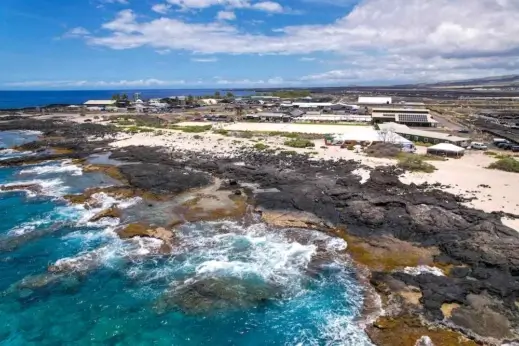Preserving the Salt Ponds of Hanapēpē
Hawaiian salt farming is an ancient practice passed down through generations. Locals hope modern problems won’t stand in the way of tradition.
Preserving the Salt Ponds of Hanapēpē
Hawaiian salt farming is an ancient practice passed down through generations. Locals hope modern problems won’t stand in the way of tradition.

A salt maker traditionally molds a salt bed at the salt ponds of Hanapēpē on Kaua‘i.courtesy of Kuuleialoha Gaisoa
Kuuleialoha Gaisoa determines whether a person is worthy of receiving her Hawaiian pa‘akai, or salt, based on whether they’ll help her protect the salt ponds of Hanapēpē on Kaua‘i.
Like the kūpuna, or ancestors, before her, “I create a product that I just give away,” says Gaisoa, 49. So, “I expect you to stand on the front line when I have to fight for this.”
Gaisoa belongs to one of 22 Kānaka ʻŌiwi (Native Hawaiian) ʻohana, or families, tasked with farming salt for centuries. Tradition dictates that their salt can’t be bought or sold—only traded or given. But in the 21st century, the flats grapple with modern problems, such as pollution and erosion. And contrary to Indigenous customs, a Hawaiian salt-farming industry has developed, with businesses marketing the product around the globe.
However, Gaisoa isn’t threatened by the corporate farms because they’re often motivated by profit, not cultural preservation, she says. “There’s nothing to compare.”
The Hanapēpē salt ponds are a place of legend. According to Gaisoa, they were discovered one day after a local woman went fishing and caught too many. Because Hawaiians hunt and gather in moderation, she walked the coastline, trying to give her extra fish away. When she couldn’t, she started to cry. At the same time, Pele, the Hawaiian goddess of fire and volcanoes, was visiting her brother, Kāmohoaliʻi, the shark god. Appearing from the bushes, Pele led the upset woman to the flats to teach her the art of making salt.

When Gaisoa first visited the salt patch with her father Frank Santos in her youth, she hated the activity. But once her two children, Waileia Tafiti and Piilani Kali, were born, she wouldn’t let them miss a day at the flats.
There, each ʻohana maintains its own section. Located on the island’s south shore, the area floods during the winter, and only once it dries do the salt makers begin cultivating. Salt season is weather-dependent, but it usually takes place from May to August.
Salt water travels underground into nearby wells, which can range from 10 to 15 feet deep. Every summer, the practitioners use buckets to remove the water, then scrape the wells’ inside walls to promote water flow.
“You literally have salt crystals on your skin—that’s how salty the water is,” says Gaisoa. Brine shrimp also help clean the wells and sweeten the salt’s taste.
The kiaʻi, or stewards, dig for black clay, then use rocks to mold it into salt beds, which measure between three and four feet wide and eight and 10 feet long. Afterward, they bake in the sun. The entire process takes between four and six hours. After well water is poured into the bed, it crystallizes, forming layers of salt flakes.
The fresh white salt sits at the top and is used as seasoning. The pink salt in the middle is given away, and the red salt at the bottom serves religious and medicinal purposes.

In the days of yesteryear, salt makers would give five-gallon buckets to those who asked, but, today, it’s typically limited to one gallon. They still barter with salt, and they have even auctioned it for noble causes. However, Gaisoa doesn’t judge the few who sell their goods.
“It’s expensive to live in Hawai‘i,” she says. “If someone is selling it on the sidelines, well, you gotta do what you gotta do.”
And 2023 counted as a bad year for salt makers. “I’m not giving out any more because I don’t have any,” says Gaisoa. “There’s only been another time in my lifetime where there was a salt shortage.”
They’ve faced other problems in recent years. During the COVID-19 pandemic, county officials moved a group of unhoused people to the adjacent Salt Pond Beach Park, and their excrement contaminated the salt flats. Today, partiers who gather in their parking lot leave trash behind. Cars driving on the beach contribute to sand erosion. A 1960s-era road built by the government through the patch is now corroding, and the salt makers are working on a plan to address it.
When the aircraft of a helicopter tour agency, Maverick Helicopters, flies overhead, they blow dust into the salt. Since 2019, Hui Hana Pa‘akai o Hanapēpē—a Kānaka ʻŌiwi nonprofit that represents the salt-farming ʻohana—has fought the company’s expansion efforts because the potential for noise, chemical runoff and pollution threatens the harvest.
“My goal before I die is to get rid of the helicopter landing pad,” says Gaisoa. “At the end of the day, people just need to be respectful of the area.”
Malia Nobrega-Olivera, 52, also belongs to a salt-making ‘ohana in Hanapēpē. She highlighted several large-scale action points to better support them, including properly citing Indigenous elders and establishing prior and informed community consent.
At Keāhole Point on Hawai‘i, Kona Sea Salt Farm also deals with external challenges, such as strong winds and storms. During the winter, the team struggles to keep up with demand because weather slows its production.
“Mother Nature always has the last word,” says Melanie Kelekolio, operations general manager and chief salt maker. Although the business sells its salt on the islands, the continental US and Japan, it still uses hands-on methods under Kelekolio’s leadership.

In 1999, she started at the nearby Natural Energy Laboratory, first growing microalgae before exploring salt production as a side project in 2004. Intrigued at the idea of making salt out of deep sea water, Kelekolio and a maintenance worker dug holes by hand to create their first hot house.
Since then, trial and error has fine-tuned the oceanfront salt farm’s methodology. Now, a 40-foot pipe extending 2,200 feet deep into the ocean sends water into the operation’s solar evaporation beds. Those tunnels are covered, letting moisture evaporate under the sunlight before the salt is harvested.
“We can’t be totally traditional” and make salt in open ponds, says Kelekolio, 56. “It’s not as clean as it would have been 100 years ago.”
And in order to sell their salt as food, the farm—owned by Sea Salts of Hawai‘i – also has to follow Food and Drug Administration regulations, which wouldn’t allow for the customary process.
The business is trying to move away from using plastic materials, although “the challenge is finding surfaces that can withstand the heat and the scope—the corrosiveness of sea salt,” says Kelekolio.
Her team has expanded to include seven full-time employees, several part-time workers and event staff—mostly kamaʻāina, or born in Hawai‘i. That aspect means “they totally appreciate the fact that we are still continuing something that is still an important part of the Hawaiian culture,” says Kelekolio.

She recognizes that they aren’t following local custom by selling their salt. But Kelekolio sees products mislabeled as Hawaiian salt at grocery stores, and she’s proud that she and others with Kānaka ʻŌiwi lineage are the ones behind their product made in Hawai‘i.
“We are actually located in a place where salt was traditionally harvested 100 years ago,” says Kelekolio said. “It really is helpful that you have Kānaka to carry it on.”
Editor’s note: Megan Ulu-Lani Boyanton identifies as part-Kanaka ʻŌiwi.
Follow us
This work is licensed under a Creative Commons Attribution-NoDerivatives 4.0 International License.
Want to republish a Modern Farmer story?
We are happy for Modern Farmer stories to be shared, and encourage you to republish our articles for your audience. When doing so, we ask that you follow these guidelines:
Please credit us and our writers
For the author byline, please use “Author Name, Modern Farmer.” At the top of our stories, if on the web, please include this text and link: “This story was originally published by Modern Farmer.”
Please make sure to include a link back to either our home page or the article URL.
At the bottom of the story, please include the following text:
“Modern Farmer is a nonprofit initiative dedicated to raising awareness and catalyzing action at the intersection of food, agriculture, and society. Read more at <link>Modern Farmer</link>.”
Use our widget
We’d like to be able to track our stories, so we ask that if you republish our content, you do so using our widget (located on the left hand side of the article). The HTML code has a built-in tracker that tells us the data and domain where the story was published, as well as view counts.
Check the image requirements
It’s your responsibility to confirm you're licensed to republish images in our articles. Some images, such as those from commercial providers, don't allow their images to be republished without permission or payment. Copyright terms are generally listed in the image caption and attribution. You are welcome to omit our images or substitute with your own. Charts and interactive graphics follow the same rules.
Don’t change too much. Or, ask us first.
Articles must be republished in their entirety. It’s okay to change references to time (“today” to “yesterday”) or location (“Iowa City, IA” to “here”). But please keep everything else the same.
If you feel strongly that a more material edit needs to be made, get in touch with us at [email protected]. We’re happy to discuss it with the original author, but we must have prior approval for changes before publication.
Special cases
Extracts. You may run the first few lines or paragraphs of the article and then say: “Read the full article at Modern Farmer” with a link back to the original article.
Quotes. You may quote authors provided you include a link back to the article URL.
Translations. These require writer approval. To inquire about translation of a Modern Farmer article, contact us at [email protected]
Signed consent / copyright release forms. These are not required, provided you are following these guidelines.
Print. Articles can be republished in print under these same rules, with the exception that you do not need to include the links.
Tag us
When sharing the story on social media, please tag us using the following: - Twitter (@ModFarm) - Facebook (@ModernFarmerMedia) - Instagram (@modfarm)
Use our content respectfully
Modern Farmer is a nonprofit and as such we share our content for free and in good faith in order to reach new audiences. Respectfully,
No selling ads against our stories. It’s okay to put our stories on pages with ads.
Don’t republish our material wholesale, or automatically; you need to select stories to be republished individually.
You have no rights to sell, license, syndicate, or otherwise represent yourself as the authorized owner of our material to any third parties. This means that you cannot actively publish or submit our work for syndication to third party platforms or apps like Apple News or Google News. We understand that publishers cannot fully control when certain third parties automatically summarize or crawl content from publishers’ own sites.
Keep in touch
We want to hear from you if you love Modern Farmer content, have a collaboration idea, or anything else to share. As a nonprofit outlet, we work in service of our community and are always open to comments, feedback, and ideas. Contact us at [email protected].by Megan Ulu-Lani Boyanton, Modern Farmer
April 11, 2024
Modern Farmer Weekly
Solutions Hub
Innovations, ideas and inspiration. Actionable solutions for a resilient food system.
ExploreExplore other topics
Share With Us
We want to hear from Modern Farmer readers who have thoughtful commentary, actionable solutions, or helpful ideas to share.
SubmitNecessary cookies are absolutely essential for the website to function properly. This category only includes cookies that ensures basic functionalities and security features of the website. These cookies do not store any personal information.
Any cookies that may not be particularly necessary for the website to function and are used specifically to collect user personal data via analytics, ads, other embedded contents are termed as non-necessary cookies.